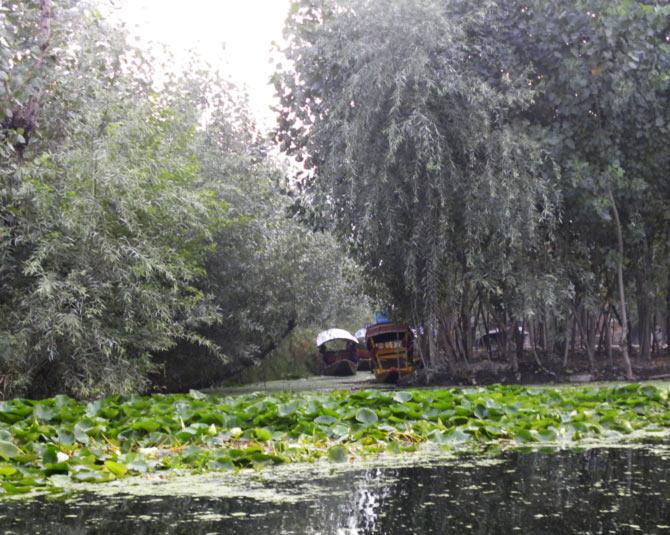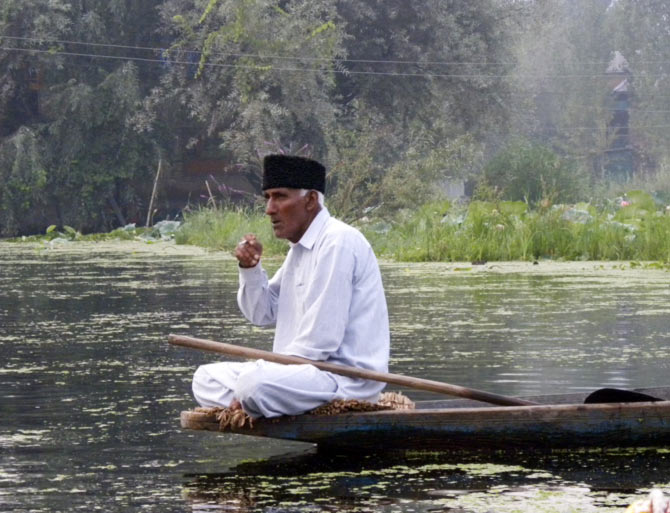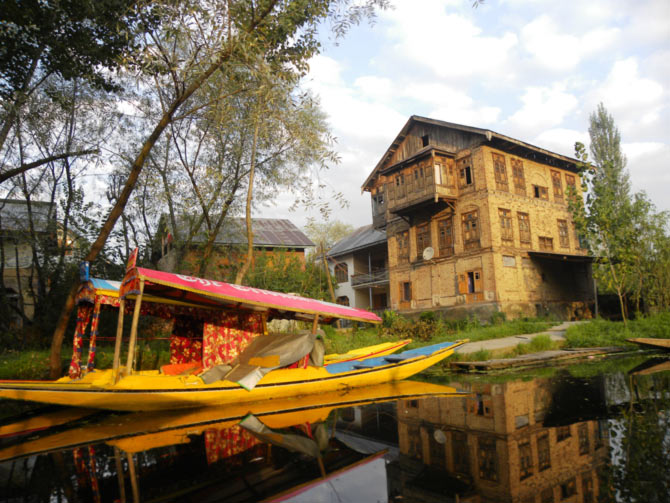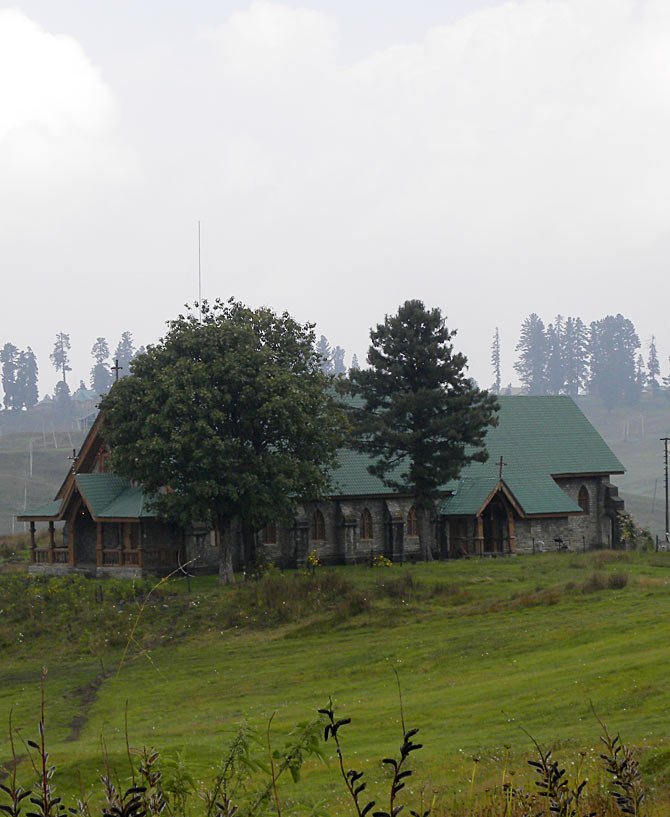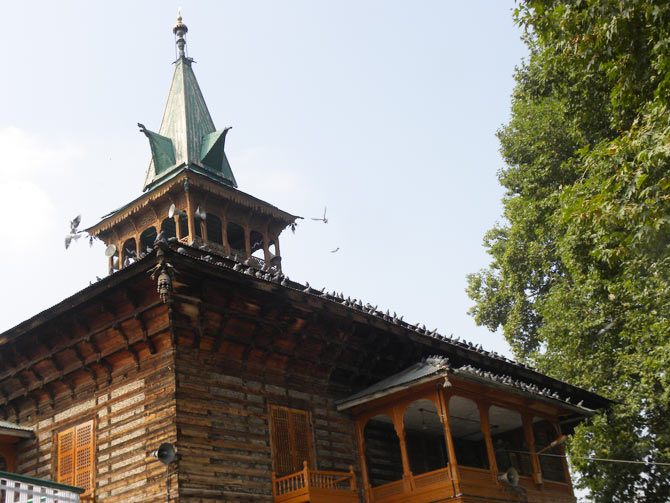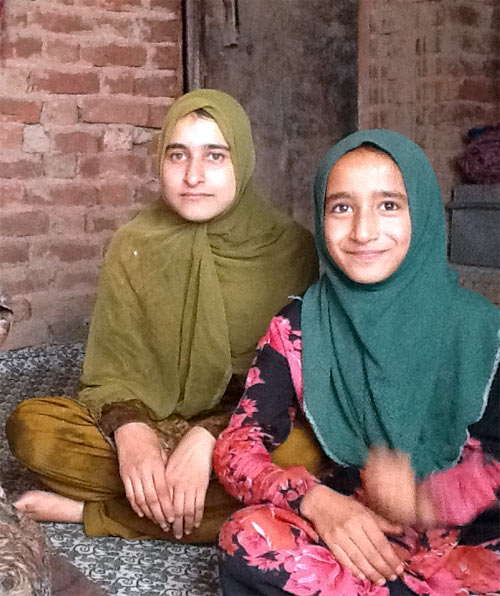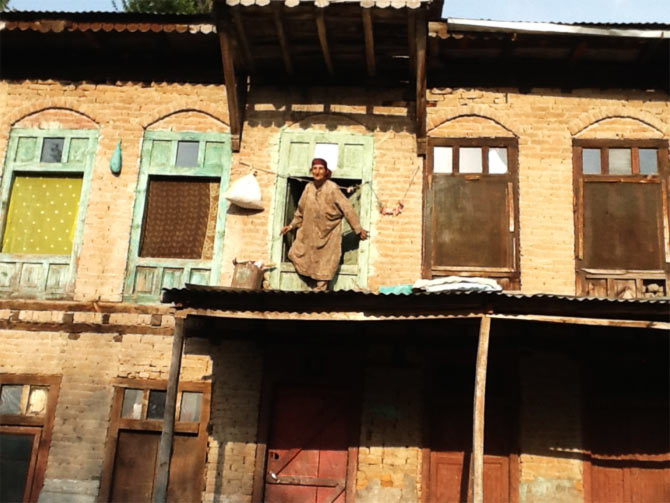 | « Back to article | Print this article |
Kashmir is delightful
Kashmir was the place I knew it would be. Delightful. Unforgettable. It is also a place all of us Indians need to experience, says Vaihayasi Pande Daniel after a recent visit to the state.
Are you travelling alone?"
"Where is your family?"
"You are from Bombay?"
"A journalist?"
This set of four questions followed me all around Kashmir.
If I wasn't a foreign tourist, what on earth was I doing touring a divinely pretty place like Kashmir all by myself, without a husband to boot. Like going on a honeymoon solo.
The questions tailed me back to Bombay too.
"You went to Kashmir? By yourself? You're kidding me? Wasn't it dangerous?"
Kashmir, as a long-standing Srinagar journalist colleague underlined to me, is normal till the next incident.
 The next incident happened within 48 hours of my arriving there, at the Lal Chowk during a bandh (apart from sporadic incidents, elsewhere in the state, at the same time). It is plainly (er, obviously) dangerous to be in the wrong place at the wrong time. "Everyone suffers from post traumatic stress disorder in Kashmir," I was told Day One.
The next incident happened within 48 hours of my arriving there, at the Lal Chowk during a bandh (apart from sporadic incidents, elsewhere in the state, at the same time). It is plainly (er, obviously) dangerous to be in the wrong place at the wrong time. "Everyone suffers from post traumatic stress disorder in Kashmir," I was told Day One.
For a few hours the famous chowk, that has often featured on newspaper front pages for decades, was deserted, unfriendly, manned by soldiers and police waving machine guns. Then it was back to business again.
Back to the same delightful Kashmir I had arrived in, two days before… The Kashmir where I absentmindedly, and horrific-ly, left a bag with a passport, an iPod, a dictaphone, cash, a portable wi-fi device, an air ticket, in the middle of a busy Srinagar bazaar for 25 minutes and it was still there on my return.
Kashmir is delightful. Unforgettable.
Your first ride on a shikara, on Dal Lake, will prove that. In a world where everything, these days, is powered by noisy, putrid engines, there is something romantic, ethereal, about gliding dreamily -- no sound except the soft slap of oars against the water -- across a still lake, so still it seems like glass.
Click on next to read further...
A journey by shikara will linger in your mind long after
A journey, pre-dawn, by shikara, away from the ghats of main Srinagar -- past the line of colourfully-named houseboats (Queen Elizabeth, Helen of Troy, The New Texas, Montana, Savoy, New Manhattan, White House, Sans Souci, New Manila, Royal Dandoo Palace; do have a peek inside some of them -- they are plush), past the photo studio shikaras, the moored floating post office -- to the sleepy settlements on other shores of the lake, will linger in your mind long after.
The silence.
That haunting, poignant, falling-off-the-map feeling.
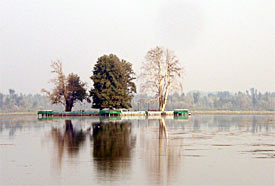 The Char Chinars (right) magically popping out of the middle of the lake. The Zabarwan Hills -- snow-flecked and more majestic in other seasons -- perfectly mirrored in the serene waters.
The Char Chinars (right) magically popping out of the middle of the lake. The Zabarwan Hills -- snow-flecked and more majestic in other seasons -- perfectly mirrored in the serene waters.
Tiny villages, many with charming old wood-and-stone houses, cling to wisps of misty marshland, between lotus ponds and canals. Traditional wooden boats are the only way to get around. Women paddle to the market. Goat herders ferry grass. The kebab boat, smoke curling from it, comes calling. Hawkers float by peddling chappals, flowers, kurta sets etc.
Many villages have a clutch of craft workshops producing an astonishing variety of delicate shawls, carpets, pherans (kurtas), papier-mache and walnut wood curios. Cute/crazy names abound – Persian Dowery (!... Seems to be Kashmir specialty: Hotel Bi-Zone, Butt’s Clinic, Mango-Bango). A little papier-mache factory, located along one of the canals, was a paradise of papier mache artistry, worth lakhs of rupees and thousands of man hours.
Click on next to read further...
Inshallah, it will stay that way...
On the flight from Mumbai, a Kashmiri coming home, for the holidays, from Muscat, said to me. "In Kashmir everyone has a house. Everybody has to live in a house." That did not prepare me for the size and beauty of the houses.
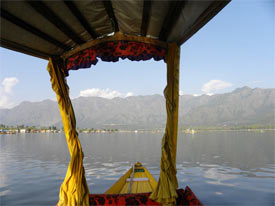 Most Kashmiris -- by the way their language is very sweet and has a strongly central Asian sound to it -- continue to have plenty of landed wealth. Their homes are sometimes three-storey high, wooden and stone, with elegantly carved trimmings.
Most Kashmiris -- by the way their language is very sweet and has a strongly central Asian sound to it -- continue to have plenty of landed wealth. Their homes are sometimes three-storey high, wooden and stone, with elegantly carved trimmings.
Public building, gardens and mosques also have a lovely historic grandeur.
You are not going to see too much of those ugly, standard-issue cement-block structures that has haunted our part of the world since the 1950s. And the landscape is uncluttered by unsightly signs and commercialism.
Inshallah, it will stay that way.
Click on next to read about visiting Gulmarg...
Travelling to 14,000 feet
Cool, alpine Gulmarg, 52 km from Srinagar, in eastern Baramulla district, in the Pir Panjal range, and very close to the LoC, is a town best visited out of the tourist season. Maybe autumn.
Even off-season, the pony-wallahs lasso you within an inch of your life, hoping valiantly to capture your business. Given that there are apparently some 7,000 of them, it is a tough dodge. Cars are not allowed beyond a point and it is obligatory to jump onto a pony (but Rs 50 goes a long way in solving that).
The main idea for visiting misty/snowy Gulmarg (or the Meadow of Flowers) with its huddle of green-roofed hotels and cottages, if you are not a skier, is to take a cable car ride (Rs 1,000 per head across 5 km) to the Afarwat peak, at nearly 14,000 feet, where not much lives or grows, except some fluorescent lichens and the army.
It is the second highest cable car in the world and was built with French collaboration. Two army camps perch on top of the peak; the closest is Sarsu where ten soldiers live. On foot, up and down the peaks, the LoC is two hours away, from the top -- so standing on the peak of Mt Afarwat you are looking across at Pakistan… And at two of the world’s eight-thousanders.
The 26,660-foot-high aloof Nanga Parbat is the ninth highest mountain in the world and one of two mountains (the other is K2) that has never been conquered in the winter. So starkly ridged, it is mostly naked of snow; hence its name.
On a rare day apparently the fierce-looking K2, the second highest mountain (28,251 ft) in the world, is also visible. Both are located in Gilgit-Baltistan area that Pakistan considers its territory.
The K2 incidentally got its strange name for a reason -- according to international mountain-naming convention, a local name gets priority and the only Balti name found for K2 was Chogori or Big Mountain, which mountaineers/explorers suspected was just a vague answer by a local to a question about the mountain’s name, according to an article in Pakistan's Express Tribune.
The ride up to the first stop, Kongdoori Station, in the noiseless bright yellow gondolas, whose windows could certainly be cleaner, takes you past tented camps of the nomadic pony-wallahs along the lower slopes. In the higher, sparsely-treed slopes, you are passing endless herds of sheep (not the pashmina variety) and their Bakarwal minders (dog and man). The police and soldiers seem to use the gondolas too to come up and down the mountain as well.
Click on next to read about the death of a young British man in Gulmarg during the colonial era...
Emperor Jehangir liked Gulmarg. So did the British
A tiny, hard-to-discover British cemetery, with a few forlorn, grassed-over graves, a golf club (the highest green in the world, that has been around since 1911) and a church are the only evidence that Gulmarg, was a much-favoured destination during colonial times, after the Mughals (emperor Jehangir was said to have visited).
Once a little paradise for homesick Britishers, all varieties of adventurers, royalty, explorers, lords/ladies arrived in this salubrious town for holiday sojourns. Just a little off the Silk Route, and close to the Himalayan kingdoms of Hunza, Nagar, Gilgit, Kashmir did not escape the intrigue surrounding the Great Game that was unfolding in Central Asia.
Adventurer and key player in the Great Game, Sir Francis Younghusband, eventually came to live in Kashmir -- he was the British representative and wrote a book called Kashmir in 1909 with evocative illustrations of the era. Lord Curzon visited as viceroy, with his lady. The town's most well-known hotel, the picturesque Nedou's (since 1888), facing the cemetery, was started up by a Dubrovnik man named Michael Nedou, who was in India to construct palaces for maharajas.
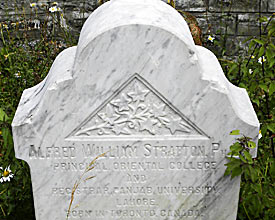 In the windswept, lonely graveyard, one of the most legible tombstones belongs to an Alfred William Stratton. I wondered who he was and how he died here at just 38.
In the windswept, lonely graveyard, one of the most legible tombstones belongs to an Alfred William Stratton. I wondered who he was and how he died here at just 38.
A little bit of research, through a 1902 American journal, turned up the fact that he was noted Canadian-American Indologist and specialist in linguistics (spoke Urdu, Hindi, Sanskrit, read the Upanishads) who arrived in Gulmarg for a holiday and died suddenly of Malta fever (brucellosis, that comes from unboiled milk and less-cooked meat), a very, very long way from home.
Standing at his grave, I could visualise that most likely a funeral service for him was conducted at St Mary’s Church, in the rolling meadow below, less than a kilometre away, and his coffin was brought here in a pony cart through the August mist.
The church, which is more than a hundred years old, with stained glass windows, but clumsily renovated, has service only on December 24 morning when tourists, the priest and worshippers arrive from Srinagar. The rest of the time, since it is located within the golf course, the church is locked up and deserted, although a caretaker is around. The caretaker Mohammed Yusuf says that at night "sher" (presumably leopards) and bears stop by.
The road from Gulmarg to Srinagar is dotted with apple and cherry orchards, walnut trees, chinars. It is a pity that more varieties of Kashmir’s apples, as well as its other gorgeous-looking vegetables do not reach Bombay. A peti of apples, containing about five dozen apples, goes for Rs 250 when you buy it fresh out of the orchard; a far cry from the Rs 110 we pay for probably two measly apples. Kashmir produces more than 13.47 lakh tonnes of apples annually, according to last year's official figures, in types you have never seen before according.
At the orchard, where I stopped, I was shown tiny green ones, light pink rosy ones, tart ones -- the names of the local varieties of apples musically trip off your tongue, Amri, American Trel, Irish Peach, , Ambri, White Dotted Red, American Apirouge, red Delicious, Golden Delicious, Hazaratbali Benoni, Cox's Orange Pippin. The orchard produces five lorries of trucks daily during the season, I was told and each truck holds 400 crates.
Click on next to read further to read about the land of the saints...
No cameras!
Khanya, an older and more traditional area of Srinagar, is the location of the Roza Bal Dargah, apart from the once-imposing Dastagir Dargah, that was burnt down in a mysterious fire.
As you enter the narrow lanes approaching this dargah there's a truck from Rajasthan unloading sheep. Apparently there' a shortage of mutton and lamb in Srinagar, locals say, (mutton sells for Rs 400 a kilo and goats are preserved for festive occasions) and therefore sheep are shipped in from Rajasthan where they have excess and eat little.
Roza Bal or the Shrine of Hazrat Youza, a tiny green mosque, panelled with green marble, is locked up. The gates are locked, as is the building itself.
I raise my camera to take a picture and many people poke their heads out of adjoining buildings and order me to stop immediately.
There are prominent signs in the dargah compound directing that photography and videography are not permitted.
The 600-700-year-old dargah (its age is anyone’s guess) is guarded from tourists because of the 'myth' that arose that the dargah is actually the tomb of Jesus Christ.
Locals give you a few reason why this confusion arose. Namely, the details of the origins and life of the saint buried in this dargah are obscure. Secondly the similarity in names between Jesus (also pronounced Yesu) and Youza.
Fearing that some believers might want to take over this tomb, neighbourhood folk began to guard it zealously. Hence it was put under police protection. Anyone entering the premises of the tomb, including the maulana caretaker, has to report to the police, locals tell you.
Research online indicates that members of the Ahmadiyya sect of Islam sought to take over this shrine. Ahmadiyya adherents, who follow the word of early 19th century Islamic thinker Mirza Ghulam Ahmad, believe Ghulam to be like a second Christ. It was Ahmad who is said to have declared in 1888 that the shrine at Khanyaar was that of Jesus Christ. But this idea did not sit well with the dargah’s Sunni believers.
 Srinagar is dotted with dargahs that have soaring spires, pyramidal roofs, tiering and square structures quite similar to temples in this area too. There seem to be many more dargahs than mosques. Ample evidence that Kashmiri Muslims have historically leaned more to a rich spiritual tradition of Sufism.
Srinagar is dotted with dargahs that have soaring spires, pyramidal roofs, tiering and square structures quite similar to temples in this area too. There seem to be many more dargahs than mosques. Ample evidence that Kashmiri Muslims have historically leaned more to a rich spiritual tradition of Sufism.
Kashmir in fact has been known as Pir Waer or the land of saints and Sufis and innumerable Sufi mystics wandered through here, or stopped by for many years at a time, from Turkistan, Iran and Central Asia. This tradition continues, in spite of the growing hold of the Salafi (Wahhabi) movement that disapproves of grave worship, which followers of Kashmiri Sufi Islam counter by saying they visit these spiritual shrines to find the blessings of Allah.
Chhatti Padshahi Gurdwara (right) is a sacred gurdwara of these parts and worth a peek and darshan. The sixth Sikh guru is said to have stopped here when he came as part of Mughal emperor, Jehangir's entourage.
Click on next to read the real reason why a trip to Kashmir is memorable...
Kashmiri warmth and hospitality reaches out to you
It is the Kashmiris that make a trip to the Valley memorable.
Within minutes of touching down in this scarred land -- and if you offer an ear, and an open mind, to hear their troubles -- you become aware of the total alienation they feel towards the Indian state, the anger they feel towards the present Omar-Abdullah-run government and the Abdullah family.
Not something surprising.
But the depth/totality of it is startling for an outsider.
Also, the simple hope that that the poorer, less literate Kashmiris have that their future would be much better if Kashmir became independent. Independence is seen as a universal panacea. Many of them have not travelled beyond Jammu, and are not aware of how improbable that dream is -- they are often ignorant of the mainstream Indian view and feel their hurt and bitterness is something the rest of us Indians would understand.
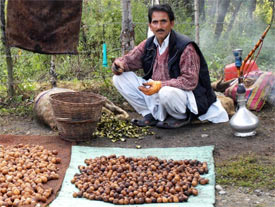 The militancy that occurred 20 years ago, they acknowledge, was something terrible that happened and unfortunately young local boys got involved and bahut galti hua. There is regret for what happened to the Kashmiri Pandits in those days, when all kinds of regrettable things (incidents) were happening.
The militancy that occurred 20 years ago, they acknowledge, was something terrible that happened and unfortunately young local boys got involved and bahut galti hua. There is regret for what happened to the Kashmiri Pandits in those days, when all kinds of regrettable things (incidents) were happening.
Kashmir today has a sizeable youth population, who have only vague memories of the worst days of the militancy and are living very much in the here and now. For them the most burning issue is the lack of jobs and why prosperity does not come to the state (650,000 youths in the state are unemployed according to the latest figures). Electricity, jobs, good roads are in short supply. The middle class prosperity that came breezing into many other parts of India, as evidenced by shiny malls, fast food chains and big brands, did not really come to Kashmir and the terrain looks pretty different around here.
The stifling of their freedom -- as they see it -- by the endless presence of the army is another cause for anger (some estimates say that more than half a million troops including CRPF are posted in the state).
I was asked what I thought about America's threats to invade Syria, a hot topic when I visited. Strangely, or not so strangely, the asker thought it was a good idea. The discussion warmed up further when he heard I had been to Syria too.
Discussions of politics make little difference to the friendly warmth and hospitality that is instantly offered to The Guest to Kashmir.
It reaches right out to you on arrival. People want you to stop by at their homes. They insist. They meet you on the road and invite you to their house. You must come over for chai, biscuits, a meal. Kashmiri cookies – they are something special and immense varieties of them are made in bakeries all over the state -– are offered wherever you go; apart from tidbits of meat, almond milk, different types of tea, the Kashmiri rusk bakarkhani.
Click on next to read about a Kashmiri meal...
A sumptuous home-cooked Kashmiri meal
They win you over in minutes with their affection and happiness to have you and their polite almost courtly hospitality.
They are simple, emotional people.
My last meal in the state was at the home of the gentleman who drove me around for five days. His family was in the handicraft trade. But when his father died suddenly of a heart attack, Zahid lost the inclination -- for now he says -- to take the business forward. He was too overwhelmed with memories of his father.
Touchingly Zahid and his family pulled out all stops to offer a special selection of sumptuous Kashmiri vegetarian food – hakh (collard greens), diiferentl varieties of paneer and eggplant -- that I would not have gotten anywhere else (given that Kashmir is famous for its Gushtabas and Rogan Joshs), checking carefully way in advance if he could cook this or would I like to eat this.
His home located on the outskirts of Kashmir was an enormous two-storey affair and the lunch was laid out on the ground on a tablecloth spread across a rich Kashmiri carpet.
And, of course, the meal was delicious.
***
One good reason to visit Kashmir is to take home a souvenir, something we thought we may never see in our lifetime -- a boarding card that says: Srinagar.
But a better and more significant reason for all Indians to visit Kashmir is to gain some understanding of this land and to meet its lovely people.
...'In truth, the kingdom surpasses in beauty all that my warmest imagination had anticipated...'
Old words. Still true.
TOP photo features you missed last week
TOP photo features you missed last weekClick on MORE to see another PHOTO features...
